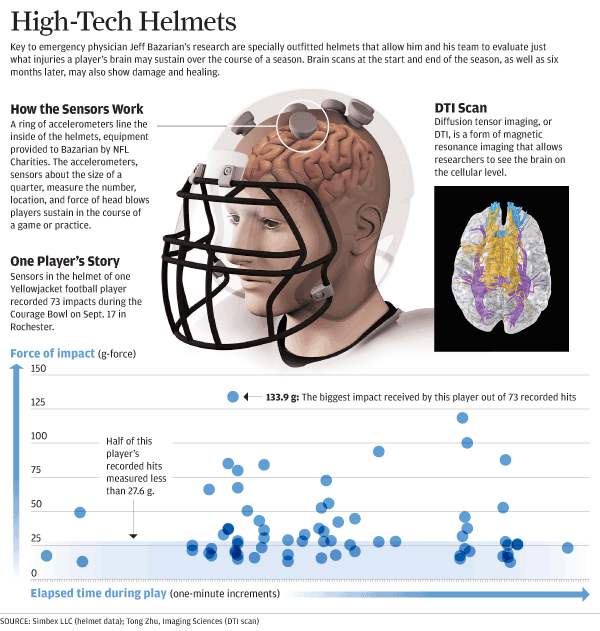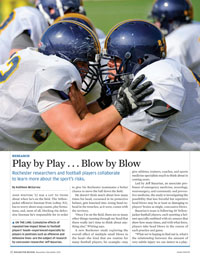In Review
 ON THE LINE: Cumulative effects of repeated low-impact blows to football players’ heads—experienced especially by players in positions such as offensive and defensive lines—are the subject of research by concussion researcher Jeff Bazarian. (Photo: Adam Fenster)
ON THE LINE: Cumulative effects of repeated low-impact blows to football players’ heads—experienced especially by players in positions such as offensive and defensive lines—are the subject of research by concussion researcher Jeff Bazarian. (Photo: Adam Fenster)John Whiting ’12 has a lot to think about when he’s on the field. The Yellowjacket offensive lineman from LeRoy, N.Y., has to worry about snap counts, play formations, and, most of all, blocking the defensive lineman he’s responsible for in order to give his Rochester teammates a better chance to move the ball down the field.
He doesn’t think much about how many times his head, cocooned in its protective helmet, gets knocked into. Going head-to-head in the trenches, as it were, comes with the territory.
“Once I'm on the field, there are so many other things running through my head that there really isn't time to think about anything else,” Whiting says.
A new Rochester study exploring the overall effect of multiple small blows to the head—the kind that are routine for many football players, for example—may give athletes, trainers, coaches, and sports medicine specialists much to think about in coming years.
Led by Jeff Bazarian, an associate professor of emergency medicine, neurology, neurosurgery, and community and preventive medicine, the study is investigating the possibility that less forceful but repetitive head blows may be at least as damaging to players’ brains as single, concussive blows. Bazarian’s team is following 10 Yellowjacket football players, each sporting a helmet specially outfitted with six sensors that show how many times, and with what force, players take head blows in the course of each practice and game.
“What we’re hoping to find out is, what’s the relationship between the amount of very subtle injury we can detect in a player’s brain and the amount of force the head receives over the course of a season?” Bazarian says.
For the past several years, the long-term danger posed to athletes—especially football players—has come into greater focus. A study commissioned by the National Football League, with results released in 2009, showed that former players in the league ran a substantially higher risk—a rate 19 times the normal one for men aged 30 to 49—of Alzheimer’s disease and related memory diseases.
“It may not be the single concussion that’s the problem long term. The brain does a pretty good job of recovering from that,” Bazarian says. “But when you have day-in, day-out hits, you don’t give the brain a chance to do what it needs to do to get better. And that may be the problem.”
The research had its beginnings in a pilot study with students at a Rochester area high school in 2007. Bazarian was looking to see if it was possible to detect brain injury from the sport on a new kind of brain scan, called defusion tensor imaging (DTI), that allows researchers to look at the brain on the cellular level.
Bazarian and his collaborators scanned the high school students at the beginning and end of the season. By the end of the season, only one student had suffered a concussion.
“We looked at the scans, and we found that the one player who’d had a concussion had a significant amount of injury on the scan—but the other nine players, who didn’t get concussed, had almost as much injury,” he says.
He applied for funding from NFL Charities, a nonprofit foundation established by the league’s 32 member clubs, to further his research, and the group has provided 10 specially designed helmets that enable Bazarian and Kirsten Ross ’11—a health project coordinator for the Department of Emergency Medicine—to track how many head blows a player receives in each game and practice, where he is hit, and with what force. The 10 participating Yellowjackets received DTI scans at the start of the season and will again at the conclusion, and six months later. They also participate in blood testing and genotyping, to help researchers get a fuller picture of their condition. Five control subjects—Rochester students, but not members of the team—are also taking part in the study.
“We tried to target players who were getting multiple repetitive hits, not necessarily the big whack. We weren’t interested in studying the wide receiver who may not have any helmet impacts for several games but then goes out for a long pass and gets concussed,” Bazarian says. “We were more interested in the offensive and defensive linemen, the guys who are hitting and getting hit on every play, in every game.”
While football hasn’t been seen as a sport as dangerous to its participants as boxing, that’s changing—and if subconcussive, repetitive blows are a threat to brain health, perceptions of the sport could change dramatically. The numbers Bazarian is collecting are steep. “After the first practice, we looked at one player’s helmet impact data on the computer, and he’d been hit 70 times,” Bazarian says. “Seventy times, one player, one practice—it wasn’t even a game. So over the course of the season, players are going to be hit on the order of a thousand times or so, I think.”
The public health implications, he notes, are significant. “There are thousands of 9- and 10-year-olds playing Pop Warner football. They may play competitively for 8 to 10 years. If these low-level head hits cause injury, and if this injury builds up from year to year, we’d better find out. And we’d better find out soon.”
 FOR THE RECORD: Kirsten Ross ’11, a health project coordinator in the Department of Emergency Medicine, assists Bazarian, wirelessly downloading the data collected on each helmet after every game and practice of the season. (Photo: Adam Fenster)
FOR THE RECORD: Kirsten Ross ’11, a health project coordinator in the Department of Emergency Medicine, assists Bazarian, wirelessly downloading the data collected on each helmet after every game and practice of the season. (Photo: Adam Fenster)So many Rochester players were prepared to take part that Bazarian had to turn some away. He hopes to secure further funding to put helmets outfitted with sensors on all players and to follow his subjects for several years.
“I think it’s the nature of the student who’s drawn to this University—it’s a research university,” says athletic trainer Eric Rozen. Bazarian credits him with making the study possible, a vital liaison between players and researchers. “He has a lot of credibility with the players that I don’t have, and they know he’s looking out for their best interest.”
While team members are interested in the research, they’re not preoccupied with the hazards of the sport. Still, “it would be hard for it not to be a concern,” says Rozen. “It’s been so out there in the public.”
“While on the field in practice and in games, I don’t feel any more or less aware of the hits I am taking, but since we now must turn in the special helmets each night after practice, I find myself looking back on any headache-inducing hits and wondering what kind of damage it may cause to my brain or what kind of force was produced. Basically, I’m very interested in the results,” says Brendan Pigeon ’13, a mechanical engineering major from Oneonta, N.Y. A linebacker for the team’s defense, Pigeon is involved in the majority of plays on the field. With 60 to 80 plays in a game, “I probably have helmet-to-helmet contact on 40 to 50 of them,” he estimates.
 (Illustration: Steve Boerner for Rochester Review)
(Illustration: Steve Boerner for Rochester Review)The research exemplifies Medical Center–College collaboration with the participation not just of the football team but also of DTI “guru”—in Bazarian’s words—Jianhui Zhong, a professor of imaging sciences and biomedical engineering at the School of Medicine and Dentistry, and Eric Blackman, a professor of physics and astronomy in the College, who will interpret the impact data when the season ends.
Bazarian is hopeful that, if he’s able to follow the students for several years, he’ll find that the brain recovers when it’s given adequate rest. “That would be best case scenario: if we see any damage, with rest, it goes away.”
The investigations could also point the way to a threshold, a number of blows or a collective force at which coaches and trainers know it’s imperative to pull a player out of a game.
“Maybe the information could be used in a preventive kind of way,” he says.

